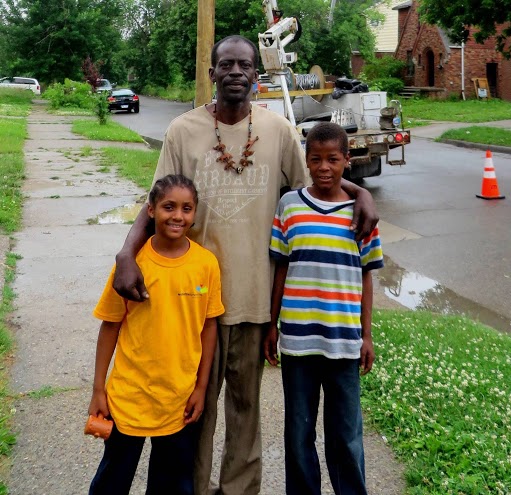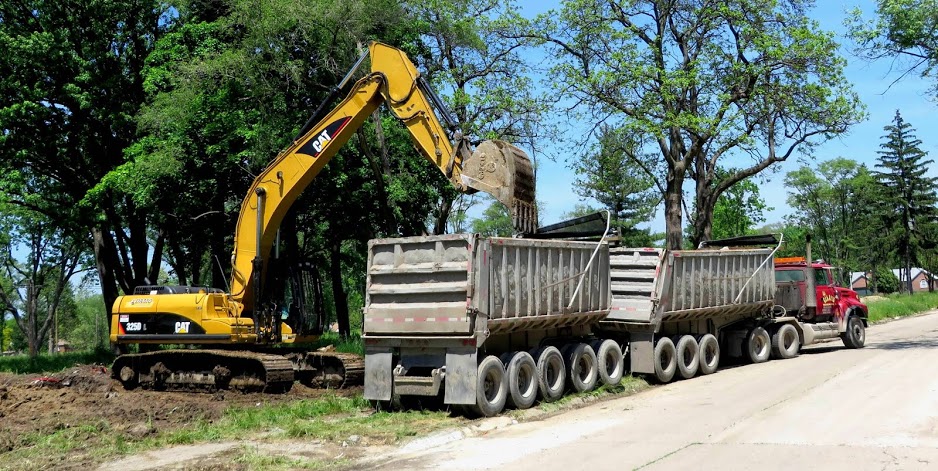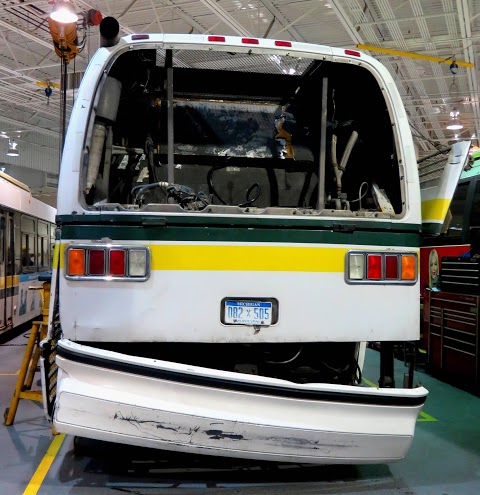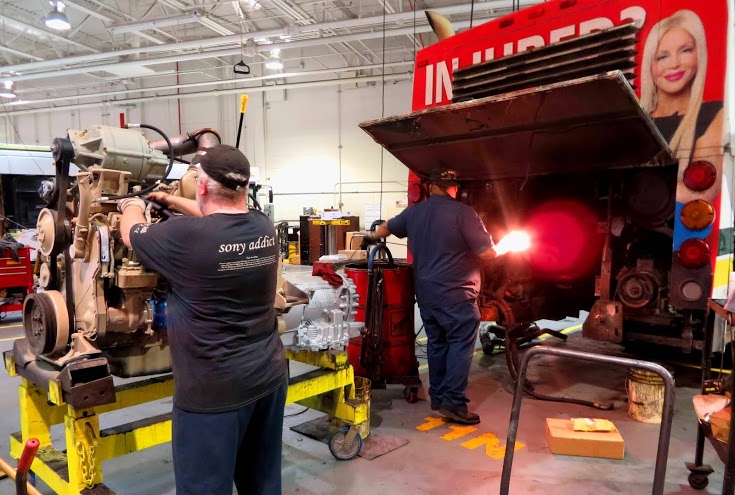Benchmark: City services
Lights, blight and buses – the Big Three when it comes to ways in which Detroiters have been disappointed over the years. When Mike Duggan became mayor in January, he vowed to demonstrate progress on each of these fronts in his first six months, part of an effort to keep more residents from leaving the beleaguered city. How has Detroit done?
Lights
I caught up with one of several crews installing streetlights around Detroit. James England is the foreman of this crew installing streetlights in the neighborhoods.
“Ten to 12 lights a day is actually what we’re doing,” he said. “We’ve got to run new wire to the backyard, to the easement, climb up the pole and run the wire back out here to the new pole and everything and then put up a new light mast. And everybody’s loving it. They’re just coming out and saying how they like the new lights and how they’re brighter. So, everything is going real well.”
Altogether the crews are exceeding the 500 installations a week Mayor Duggan wants. More than 9,000 new lights are up.
This particular streetlight is going up in front of Cedrick Bell’s house and, like most Detroiters, he’s pretty happy about it.
“It’s a crime deterrent,” Bell said. “We have a nice little community right here in our own block. It’s a basic service that we really need and desire. And they’ve been very professional and quick about their job, I must say.”
It’s been raining and the lineman in the bucket truck gets surprised by a spark from the live wire he’s hooking up to the light. Dave Martin says they do run into problems occasionally.
“Dealing with the dogs and the garbage, you know, that’s probably the worst part of the job,” Martin said. “But people have been nice to us, so it makes up for it.”
Crews say neighbors were so happy to see lights this past winter, they’d bring the crews coffee or hot chocolate, or offer to help however they could.
Crews started putting up lights in February once the Public Lighting Authority was established. It’s independent of the city although the mayor and the city council appoint its board members.
Odis Jones is the CEO of the authority. He says since the new lights are brighter LEDs, they won’t need to install as many for the same coverage.
“You had 88,000 lights before, but only 50 percent of them were working. So, now you’re going to have 65,000 lights in the city that are working, that’s being maintained in the appropriate way.”
The old high-pressure sodium lights and mercury vapor lights were wired in a way that if one light went down a whole line of them did, like old Christmas tree lights. And a lot went down because scrappers would steal the valuable copper. These new lights are wired with cheaper aluminum. The new lights will also last four to five times longer than the old lights, needing to be replaced every 15 to 20 years.
The electric cost for these LED streetlights is 60 to 70 percent less because they use a lot less power. There’s another plus. Those 88,000 old streetlights… the city had to pay a set fee for them whether they were lit or not. That cost $28 million a year.
So Jones says fewer, less expensive lights to power and maintain means a big drop in cost.
“We’re estimating the electric cost for the city is going to go down to approximately $5 million.”
Jones says shifting the responsibility from the bankrupt city to this new lighting authority is they only way the city could make the shift to lights that not only work, but also save power.
“You know, it is just so much more energy efficient to go LEDs,” Jones said. “And we’re leading the country in doing that.”
If the Public Lighting Authority of Detroit stays on track, all the neighborhoods will be lit by the end of next year. All the thoroughfares will have the new streetlights by the end of 2016.
The Authority also just got its credit rating upgraded to A-minus by Standard & Poor's. That means it will be able to issue bonds to pay for the lights. That debt will be paid back by the utility tax Detroit residents pay.
For people such as Leslie Carse, those new lights make a difference.
“A lot of difference,” Carse said. “You can actually see now when it gets dark out. It’s so much better.”
Blight
Every Detroit mayor for decades has talked about blight. There have been plans and efforts to demolish burned out houses, tear down crumbling buildings, and selling vacant lots to next door neighbors. But the pace of demolition has not kept up with the number of people walking away from properties.
Until recently, no one had a really good handle on how big the problem was or how much money it would take to clean up the mess.
That changed last month when the Detroit Blight Removal Task Force, working with Duggan, issued a major report. One of the co-chairs is Quicken Loans founder Dan Gilbert.
“So when you add it all together,” Gilbert said, “30 percent of all the structures in the city of Detroit – this has nothing to do with vacant land – are blighted, or 70,500 of them.”
Gilbert explained that just to tear down the houses and small apartments that are beyond saving would cost $850 million. For a bankrupt city, that’s a lot of cash. But a combination of federal money, private donations, fire escrow funds, and money set aside in the city’s bankruptcy plan all add up.
“We’ve already got $456 million of the $850 million that we need,” Gilbert said.
But that’s just for the houses in the neighborhoods. It’ll cost more than a billion dollars on top of the $850 million to tear down the larger abandoned commercial and industrial buildings.
Duggan says, still, this is a good start.
“Six months ago we had no strategy and no funding,” Duggan contended. “We’re standing here today; we’ve got the strategy and we’re getting started on the funding and I’m very excited about our future.”
Under Duggan, demolition crews increased the number of tear downs from about 150 a month to hundreds a month, the city said.
“They’ve identified the worst of the houses and they’re demo-ing,” Duggan said. “We expect by fall to be up to 800 a month.”
And the city is selling houses.
The mayor’s Facebook site is like looking at a real estate agent’s website. Right now 14 houses a week are being sold to people willing to fix them up and make sure they’re occupied.
The city is also going after homeowners in upscale neighborhoods to fix up their homes and suing those who don’t.
Most of the people in the neighborhoods are happy about the demolitions.
The Brightmoor neighborhood is being cleared of abandoned houses and vacant lots are being cleaned up. Hundreds of blighted structures have been torn down during the last two years.
Lowanda Anderson says the 98 acres of cleared lots have made the neighborhood safer.
“It means a whole lot,” Anderson said. “Where the people won’t be getting raped and kids won’t be getting killed in them.”
But there are concerns about what happens next.
John George is executive director and co-founder of Motor City Blight Busters Detroit. He works in the Brightmoor and Old Redford neighborhoods. He says the neighbors want to have some input on what happens to that vacant land.
“We’re willing to work with anyone that’s willing to work with us,” George said. “But we also want to have a degree of self-determination of what we see happen with this land after it’s cleared.”
George says he warned Duggan to be careful about the campaign promises he was making when he was running for office.
“Please, don’t promise us anything unless you really plan on delivering,” George said he told the then-candidate. “And, again, he kind of– I caught him off guard, but he must have taken it to heart because everything that he’s promised he is doing. And, I’m so proud of our mayor and so excited about the possibilities of a stabilized and revitalized Motor City.”
But there are a lot of obstacles ahead for the mayor and the city.
There’s that more than a billion dollars to come up with to demolish the existing blight. Fewer than half of Detroit’s residents are paying their property taxes. That means more tax foreclosures and more houses to sell or demolish in the future.
But for the first time Detroit has a fully thought-out plan that could eliminate existing blight in five years. That could help slow the departure of current residents and even attract new families and businesses to the city.
Buses
One-third of Detroit households don’t have a car. They rely on the bus system. But it’s broken.
People at the Rosa Parks Transit Center in downtown Detroit disagree over whether it’s gotten any better since Duggan took over the Detroit Department of Transportation.
A sampling of riders’ comments:
“They come late all the time,” Antoine Burton said. “I’m never on time for jobs and nothing. They always come late.”
“I’ve seen more of them out there,” another rider said, “a little bit more adhering to the schedule.”
“Well, they’re still running late all the time,” said Phil Gauley.
“I think he’s got more buses out here now,” noted Derrick Hugh.
“DDOT bus system is terrible,” sighed Anthony Moore.
So a bit of a mixed bag. Some people do give the mayor credit for trying.
“There are some days where things seem to be working pretty (well) and other days that they don’t,” said Megan Owens, the nonprofit executive director of Transportation Riders United.
She said it’s hard to measure whether things are improving because the bus service stopped publishing the daily pull-out rate. That’s the actual number of buses that operate versus the number scheduled for a day.
“So we don’t have any explicit data to show concrete improvements,” Owens said.
At the main garage at DDOT headquarters, they’re working to get more buses on the road.
Detroit needs 270 buses to properly serve its 100,000 passengers a day. The city only has 228 buses and a lot of them are broken down.
“Right now we are getting out a little bit over 200- 201, 202,” said Dan Dirks, the DDOT director. “And that contrasts when the mayor took office, we were in the 150-160 range.” (In January, Duggan promised 225 buses on the road by the six-month mark.)
I asked him why he stopped posting those pull-out rates.
“It’s a matter of getting to a decent level,” Dirks said. “Once we get close to the 228 number, I’ll feel very confident. It’s really a preference on my part.”
But shouldn’t the public be able to see those rates?
“Yeah,” he said, “they absolutely should.”
But they won’t. Not until Dirks and the mayor like the numbers.
The bus fleet is aging.
George Robinson is a mechanic with DDOT. He says the streets of Detroit are rough on the vehicles.
“Can you imagine buses running 24/7 most of the time and high maintenance?” Robinson said. “You got a bus 10 years old, nine years old, the older it is, the more work it takes to keep it on the road.”
The city has hired more mechanics. It’s also hired more drivers, who are being trained. It’s fixed the problems with parts suppliers; the city hadn’t been paying its bills.
And new buses might be coming. During Duggan’s State of the City address in February, he indicated the Obama administration was helping Detroit get 50 new buses. “And we’re going to have these buses on the street this fall,” the new mayor said. “We’re going to start to make a difference.”
But those 50 buses are not a done deal. Until the feds actually deliver, there’s the chance it could all fall apart.
Dirks says Detroit has a more certain opportunity to get 10 to 13 other buses through an EPA air quality program.
“So, if we’re lucky, we could get anywhere between 60 and 63 new” buses, he said. “Worst case scenario we’ll get 10 to 13. And we’re hoping to hear any day from the feds on the status of the 50.”
Getting Detroit back to work depends on those new buses. Owens with Transportation Riders United says getting a job when you’re dependent on the city transit is really tough.
“Is the city really going to be able to grow and succeed without people able to get to jobs?” she asked. “I mean people are riding public transit to make money or to spend money. The city needs people doing a heck of a lot more of both.”
See what new members are saying about why they donated to Bridge Michigan:
- “In order for this information to be accurate and unbiased it must be underwritten by its readers, not by special interests.” - Larry S.
- “Not many other media sources report on the topics Bridge does.” - Susan B.
- “Your journalism is outstanding and rare these days.” - Mark S.
If you want to ensure the future of nonpartisan, nonprofit Michigan journalism, please become a member today. You, too, will be asked why you donated and maybe we'll feature your quote next time!


 Dave Martin of the Public Lighting Authority installs new LED streetlights on Chatsworth in Detroit. (Bridge photo by Lester Graham)
Dave Martin of the Public Lighting Authority installs new LED streetlights on Chatsworth in Detroit. (Bridge photo by Lester Graham) Detroit resident Cedrick Bell says new lights installed on his street will help deter crime. (Bridge photo by Lester Graham)
Detroit resident Cedrick Bell says new lights installed on his street will help deter crime. (Bridge photo by Lester Graham) Detroit’s Brightmoor neighborhood is being cleared of abandoned homes. (Bridge photo by Lester Graham)
Detroit’s Brightmoor neighborhood is being cleared of abandoned homes. (Bridge photo by Lester Graham) Residents give mixed reviews on whether bus service has improved under Mayor Duggan, though the city says more buses are now on the streets. (Bridge photo by Lester Graham)
Residents give mixed reviews on whether bus service has improved under Mayor Duggan, though the city says more buses are now on the streets. (Bridge photo by Lester Graham) Detroit’s aging fleet of city buses is nothing to smile about. (photo by Lester Graham)
Detroit’s aging fleet of city buses is nothing to smile about. (photo by Lester Graham) As Detroit waits for 50 new buses promised by the feds, it must keep its battered buses running. Here, workers install a new engine. (Bridge photo by Lester Graham)
As Detroit waits for 50 new buses promised by the feds, it must keep its battered buses running. Here, workers install a new engine. (Bridge photo by Lester Graham)